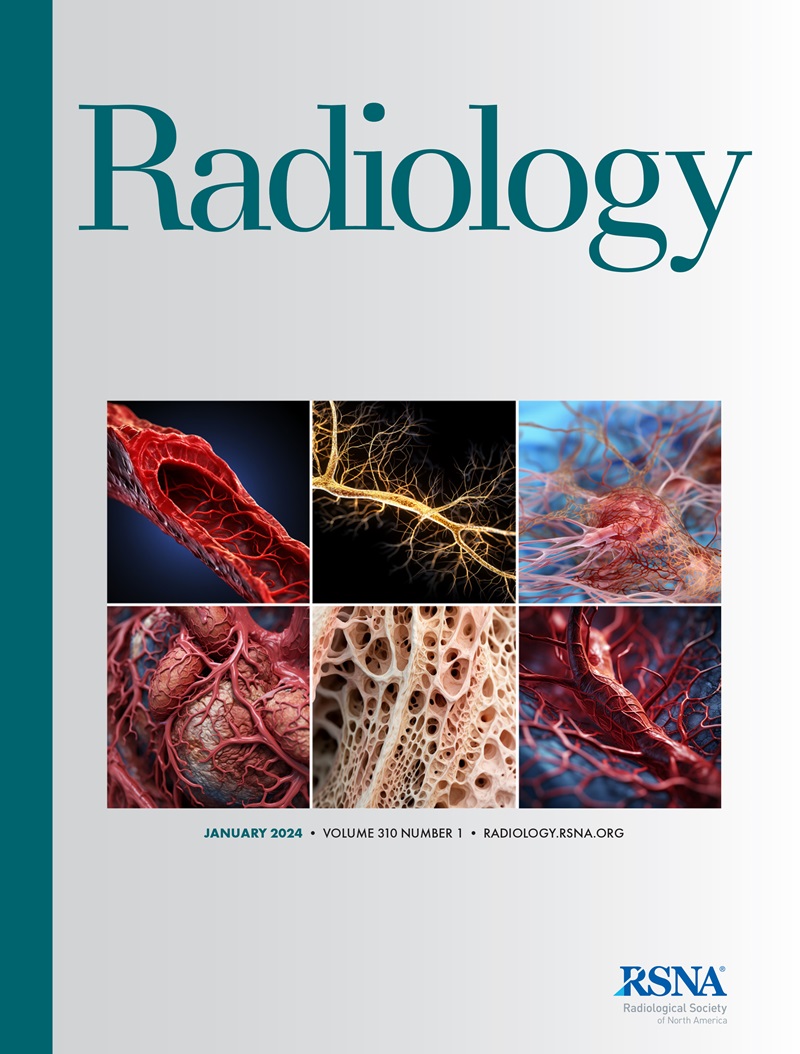Eric Wehrenberg-Klee, Thomas An, Pedram Heidari, Carlos Huesa-Berral, Matthew R Dreher, Amanda Eldridge, Kirk Fowers, Jan Schuemann, Alejandro Bertolet
下载PDF
{"title":"SPECT/CT Dosimetry of Bronchial Artery <sup>99m</sup>Tc Macroaggregated Albumin Injection in Pulmonary Malignancies: Feasibility Evaluation of Bronchial Artery <sup>90</sup>Y Radioembolization.","authors":"Eric Wehrenberg-Klee, Thomas An, Pedram Heidari, Carlos Huesa-Berral, Matthew R Dreher, Amanda Eldridge, Kirk Fowers, Jan Schuemann, Alejandro Bertolet","doi":"10.1148/radiol.240331","DOIUrl":null,"url":null,"abstract":"<p><p>Background External beam radiation therapy for primary and secondary pulmonary malignancies has limited utility for treating ultracentral tumors (ie, adjacent to the proximal bronchial tree or heart) or multiple metastases due to either radiation to central organs at risk (OARs) or extensive lung tissue exposure. Bronchial artery yttrium 90 (<sup>90</sup>Y) radioembolization may be a therapeutic option for these patients. Purpose To evaluate the feasibility of bronchial artery <sup>90</sup>Y radioembolization using technetium 99m (<sup>99m</sup>Tc) macroaggregated albumin (MAA) injection as a surrogate for <sup>90</sup>Y microspheres and to use SPECT/CT dosimetry to assess <sup>99m</sup>Tc-MAA distribution and calculated anticipated <sup>90</sup>Y doses to tumors and OARs. Materials and Methods In this prospective clinical trial, study participants with either primary lung cancer or pulmonary metastases were enrolled between August 2020 and October 2023 from a single academic medical center. All participants underwent bronchial artery embolization for malignancy-induced hemoptysis prophylaxis. <sup>99m</sup>Tc-MAA was injected via bronchial arteries, followed by bland embolization. SPECT/CT imaging and Monte Carlo simulations were used to evaluate <sup>99m</sup>Tc-MAA distribution and predict <sup>90</sup>Y doses. Predicted <sup>90</sup>Y doses to tumors and OARs are reported as means ± SDs. Results Eight participants (mean age, 63.0 years ± 13.58; six [75%] male participants) were included. All had ultracentral tumors, and four had four or more tumors. SPECT/CT revealed a concentrated <sup>99m</sup>Tc-MAA accumulation in tumors, with a mean tumor-to-normal tissue ratio of 22.71 ± 20.17. Simulations indicated that a <sup>90</sup>Y biologically effective dose (α/β ratio of 10 Gy) of 175.7-3173.6 Gy (mean, 778.8 Gy ± 981.9) could be delivered to all tumors while remaining under OAR toxicity thresholds. Conclusion SPECT/CT dosimetric analysis of <sup>99m</sup>Tc-MAA injected via the bronchial artery for pulmonary malignancy suggests that bronchial artery <sup>90</sup>Y radioembolization is feasible and could be an alternative treatment for patients unable to receive external beam radiation therapy. ClinicalTrials.gov Identifier: NCT04105283 © RSNA, 2025 <i>Supplemental material is available for this article.</i></p>","PeriodicalId":20896,"journal":{"name":"Radiology","volume":"314 2","pages":"e240331"},"PeriodicalIF":12.1000,"publicationDate":"2025-02-01","publicationTypes":"Journal Article","fieldsOfStudy":null,"isOpenAccess":false,"openAccessPdf":"https://www.ncbi.nlm.nih.gov/pmc/articles/PMC11868849/pdf/","citationCount":"0","resultStr":null,"platform":"Semanticscholar","paperid":null,"PeriodicalName":"Radiology","FirstCategoryId":"3","ListUrlMain":"https://doi.org/10.1148/radiol.240331","RegionNum":1,"RegionCategory":"医学","ArticlePicture":[],"TitleCN":null,"AbstractTextCN":null,"PMCID":null,"EPubDate":"","PubModel":"","JCR":"Q1","JCRName":"RADIOLOGY, NUCLEAR MEDICINE & MEDICAL IMAGING","Score":null,"Total":0}
引用次数: 0
引用
批量引用
Abstract
Background External beam radiation therapy for primary and secondary pulmonary malignancies has limited utility for treating ultracentral tumors (ie, adjacent to the proximal bronchial tree or heart) or multiple metastases due to either radiation to central organs at risk (OARs) or extensive lung tissue exposure. Bronchial artery yttrium 90 (90 Y) radioembolization may be a therapeutic option for these patients. Purpose To evaluate the feasibility of bronchial artery 90 Y radioembolization using technetium 99m (99m Tc) macroaggregated albumin (MAA) injection as a surrogate for 90 Y microspheres and to use SPECT/CT dosimetry to assess 99m Tc-MAA distribution and calculated anticipated 90 Y doses to tumors and OARs. Materials and Methods In this prospective clinical trial, study participants with either primary lung cancer or pulmonary metastases were enrolled between August 2020 and October 2023 from a single academic medical center. All participants underwent bronchial artery embolization for malignancy-induced hemoptysis prophylaxis. 99m Tc-MAA was injected via bronchial arteries, followed by bland embolization. SPECT/CT imaging and Monte Carlo simulations were used to evaluate 99m Tc-MAA distribution and predict 90 Y doses. Predicted 90 Y doses to tumors and OARs are reported as means ± SDs. Results Eight participants (mean age, 63.0 years ± 13.58; six [75%] male participants) were included. All had ultracentral tumors, and four had four or more tumors. SPECT/CT revealed a concentrated 99m Tc-MAA accumulation in tumors, with a mean tumor-to-normal tissue ratio of 22.71 ± 20.17. Simulations indicated that a 90 Y biologically effective dose (α/β ratio of 10 Gy) of 175.7-3173.6 Gy (mean, 778.8 Gy ± 981.9) could be delivered to all tumors while remaining under OAR toxicity thresholds. Conclusion SPECT/CT dosimetric analysis of 99m Tc-MAA injected via the bronchial artery for pulmonary malignancy suggests that bronchial artery 90 Y radioembolization is feasible and could be an alternative treatment for patients unable to receive external beam radiation therapy. ClinicalTrials.gov Identifier: NCT04105283 © RSNA, 2025 Supplemental material is available for this article.

 求助内容:
求助内容: 应助结果提醒方式:
应助结果提醒方式:


